Trabzon, a city in the northeast of Turkey, is home to a wide variety of bird species. The city provides a unique habitat for the birds, with its vast mountain ranges, lush green forests, and beautiful Black Sea coastline.
There are over 140 different species of birds that live in Trabzon, ranging from eagles and vultures to warblers and woodpeckers. Each species has its own distinct characteristics and behaviors, making them a delight to watch and study.
Bird-watching in Trabzon is a popular activity amongst visitors, as it allows them to observe and appreciate these amazing creatures in their natural habitat.
Whether you’re interested in seeing the majestic raptors of the mountains or the colorful songbirds of the forests, Trabzon is sure to provide you with an unforgettable bird-watching experience.
1. Common Wood Pigeon
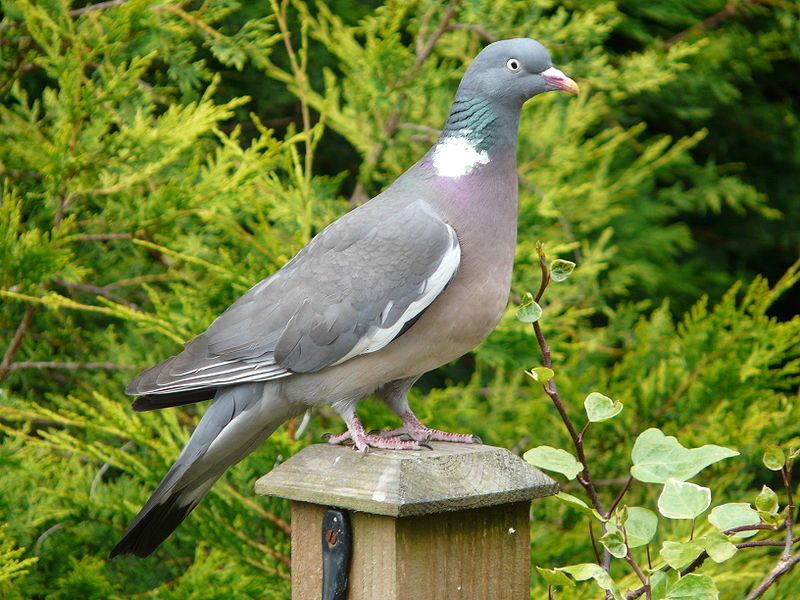
The common wood pigeon is a species of dove and pigeon found in the western Palearctic region. It is a large bird with distinctive white patches on its wings and grey-brown feathers on its body. It belongs to the genus Columba, which includes other species such as the rock dove.
The wood pigeon is considered to be an important game bird in many parts of Europe and is hunted for sport. It is also a popular bird for bird watchers, with its large size and distinctive markings making it easily identifiable.
The wood pigeon feeds mainly on grains and seeds, but will also eat fruits and berries. It also eats insects and worms and is known to occasionally raid crops, leading to its reputation as a nuisance in some areas.
It nests in trees and will use tree cavities or nest boxes if provided. The wood pigeon is an important species in its range, and its population is generally stable.
| Kingdom | Animalia |
| Phylum | Chordata |
| Class | Aves |
| Order | Columbiformes |
| Family | Columbidae |
| Genus | Columba |
| Species | C. palumbus |
2. Eurasian Coot
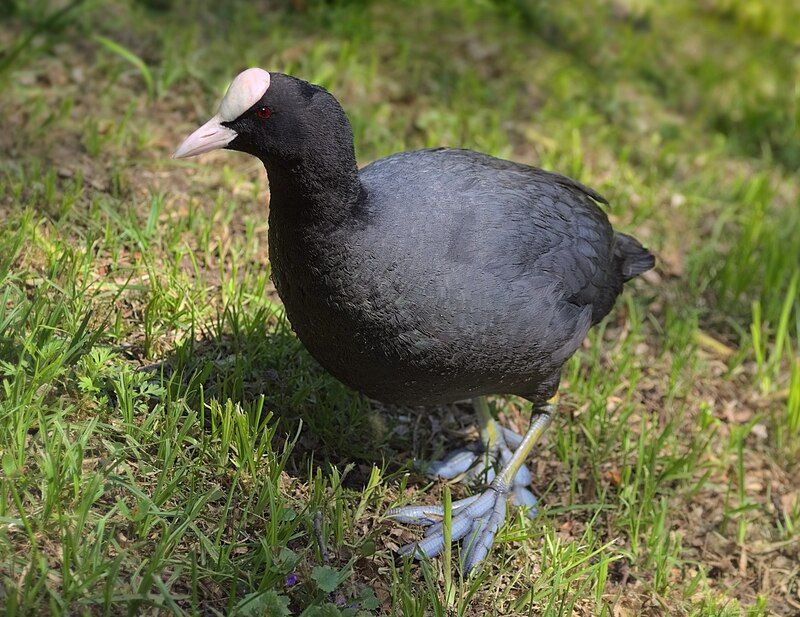
The Eurasian coot is a species of bird that belongs to the Rallidae family, which includes the rails and crakes. This species is found in many regions across the world, including Europe, Asia, Australia, New Zealand, and parts of North Africa.
It has a distinctive look with a slaty-black body, a glossy black head, and a white bill with a white frontal shield. This species of bird is a strong swimmer and is common in rivers, lakes, ponds, and marshes.
It is also adept at diving and can stay underwater for up to 30 seconds. Its diet consists of a variety of aquatic vegetation, such as algae, plants, and insects. When it comes to nesting, the Eurasian coot prefers to build its nest on the edge of the water or in shallow water.
The nest is usually made of vegetation and is lined with feathers and down. The female lays between 4 and 8 eggs, and both parents take part in incubation. The Eurasian coot is a bold and noisy bird, often making loud calls and noises.
It is also quite territorial and will defend its nest with vigor. Overall, this species is a common sight in many parts of the world and is sure to remain a favorite of bird enthusiasts and casual observers alike.
| Kingdom | Animalia |
| Phylum | Chordata |
| Class | Aves |
| Order | Gruiformes |
| Family | Rallidae |
| Genus | Fulica |
| Species | F. atra |
3. Cuculus Canorus
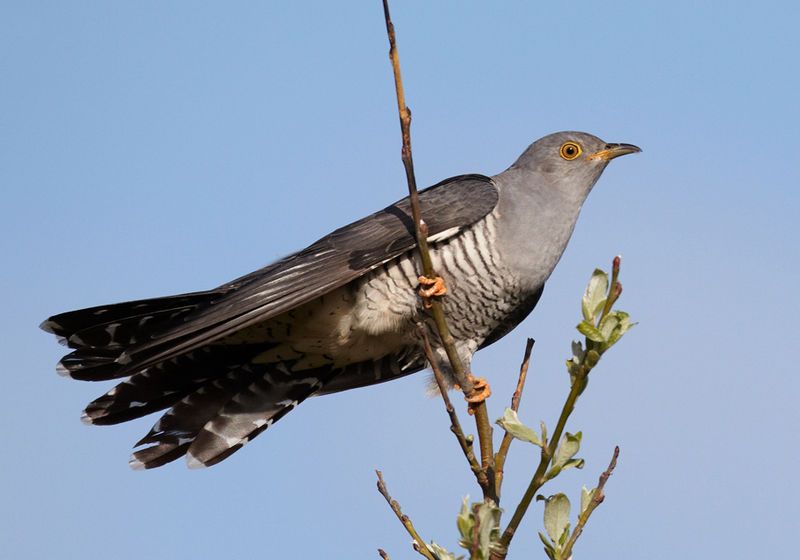
The common cuckoo is a species of bird that belongs to the Cuculiformes, a group of birds that also includes roadrunners, anis, and coucals. This particular species of bird is found throughout Europe and Asia during the summer months before migrating to Africa for the winter.
This species of cuckoo is particularly widespread, as its range spans many countries and continents. The common cuckoo is a medium-sized bird, with a gray body and a black-streaked white head.
Its long tail and pointed wings make it highly adaptable to different environments. During the summer months, the cuckoo is most commonly seen in open meadows and woodlands, where it feeds mainly on insects and other small creatures.
It is also known to feed on fruits and seeds. During the winter months, the common cuckoo migrates to Africa, where it is a more solitary bird.
It is usually seen in scrubby grasslands and savannas, and it feeds mainly on the fruits and seeds of the local vegetation. The common cuckoo is a fascinating species of bird, as its range is so vast and its behavior so varied.
It is an important part of the ecosystem, as it helps to maintain the balance of its environment by eating a variety of different foods.
| Kingdom | Animalia |
| Phylum | Chordata |
| Class | Aves |
| Order | Cuculiformes |
| Family | Cuculidae |
| Genus | Cuculus |
| Species | C. canorus |
4. Eurasian Collared Dove
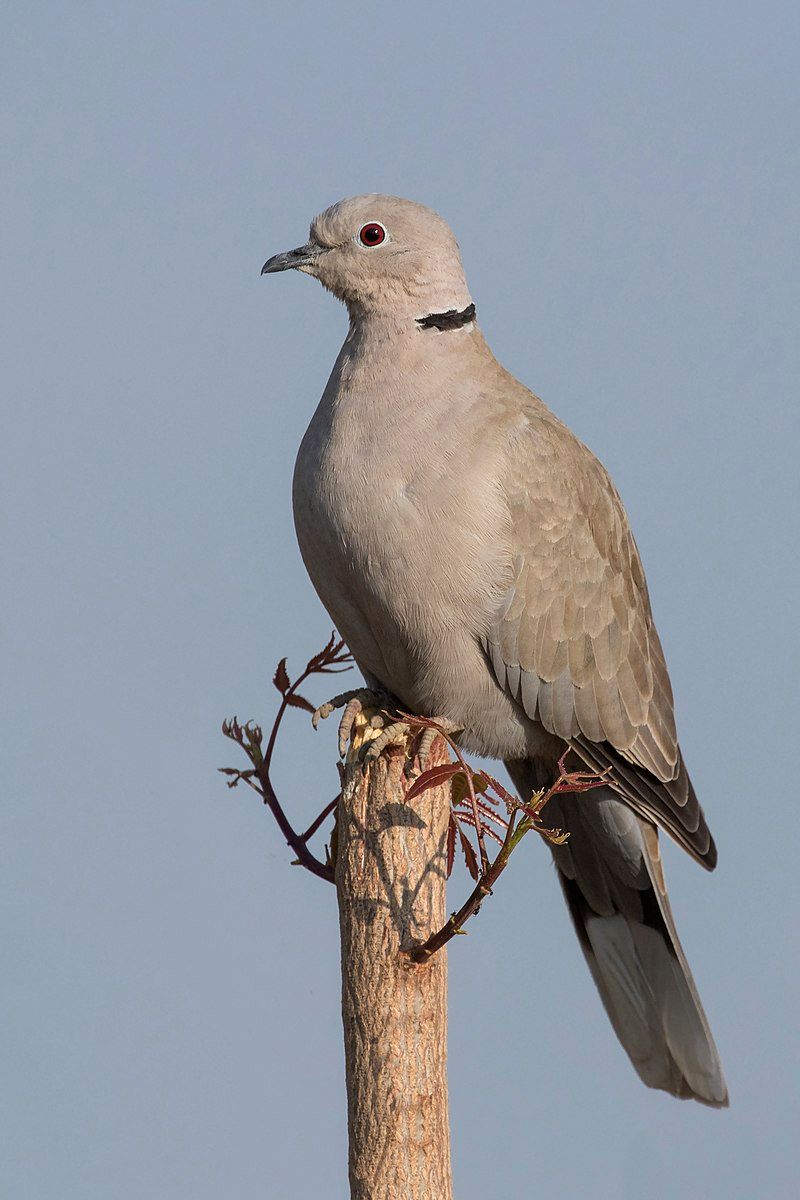
The Eurasian collared dove is a species of dove native to Europe and Asia. This species has since been introduced to Japan, North America, and the Caribbean Islands.
As a result of its vast global range, as well as its increasing population trend, it has been given a Least Concern status by the International Union for Conservation of Nature and Natural Resources (IUCN).
This status has been in place since 2014, which reflects the species’ overall stability in its natural environment.
The Eurasian collared dove is a common sight across its range; it is often found near human settlements and can be seen in a variety of habitats, including grasslands, woodlands, and agricultural areas.
This dove species is known to eat a wide range of foods, both in the wild and in captivity, including seeds, grains, and small insects. Its adaptable nature and wide range have allowed it to remain a stable species despite human-induced changes in the environment.
| Kingdom | Animalia |
| Phylum | Chordata |
| Class | Aves |
| Order | Columbiformes |
| Family | Columbidae |
| Genus | Streptopelia |
| Species | S. decaocto |
5. Black Stork
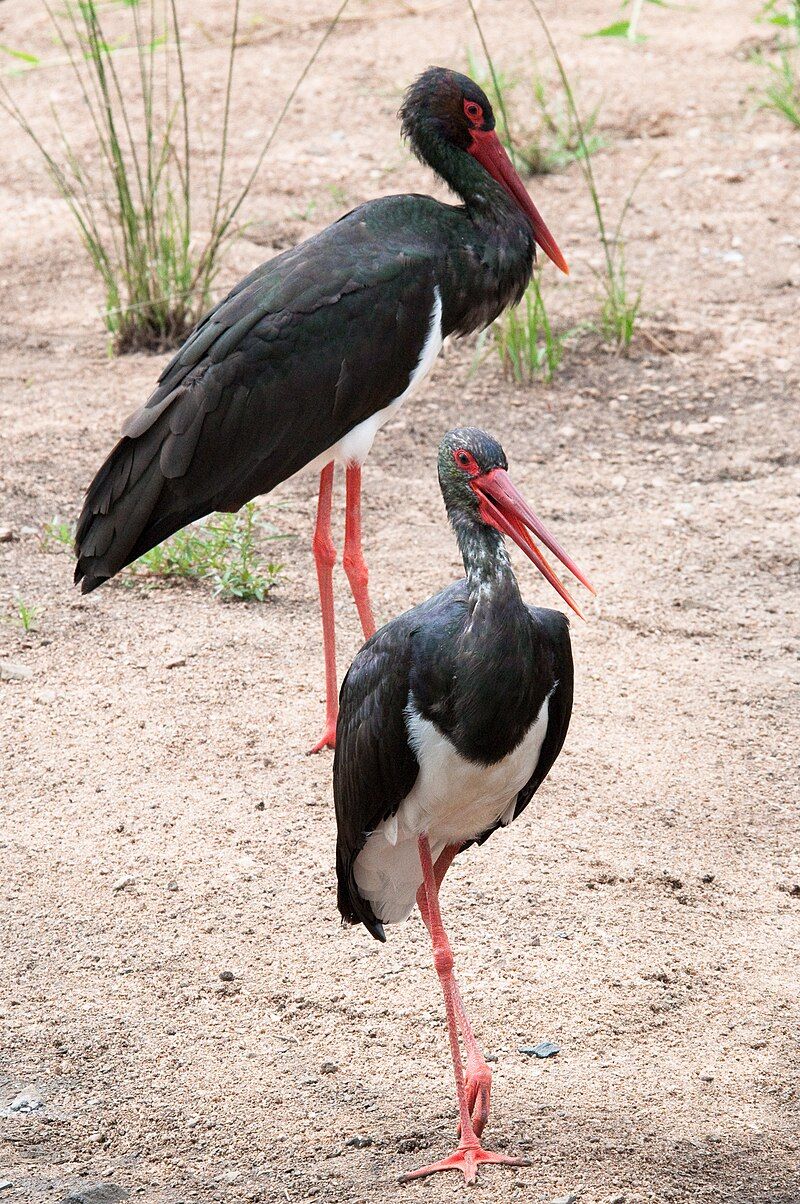
The black stork is a species of bird belonging to the family Ciconiidae, a family of mostly large wading birds. It was first described by the famed naturalist Carl Linnaeus in his 10th edition of Systema Naturae, a landmark work in the classification of living organisms.
The black stork is a large bird, with a wingspan of around 150 cm and a body length of up to 75 cm. It is mainly black in color, with white under-tail feathers, a white belly, and a long red bill. Its legs are also red, while its eyes are yellow.
It is mainly found in the Palearctic region, ranging from the Iberian Peninsula to eastern Siberia. It is a solitary bird, rarely seen in groups, but may form pairs during the breeding season. It typically feeds on fish, amphibians, and other small animals.
Breeding takes place in late spring to early summer, with the female laying 2-4 eggs in a shallow nest on the ground. The eggs are incubated for around 30 days, and the chicks fledge after another 55-60 days. The black stork is listed as Near Threatened on the IUCN Red List.
| Kingdom | Animalia |
| Phylum | Chordata |
| Class | Aves |
| Order | Ciconiiformes |
| Family | Ciconiidae |
| Genus | Ciconia |
| Species | C. nigra |
6. Great Bustard
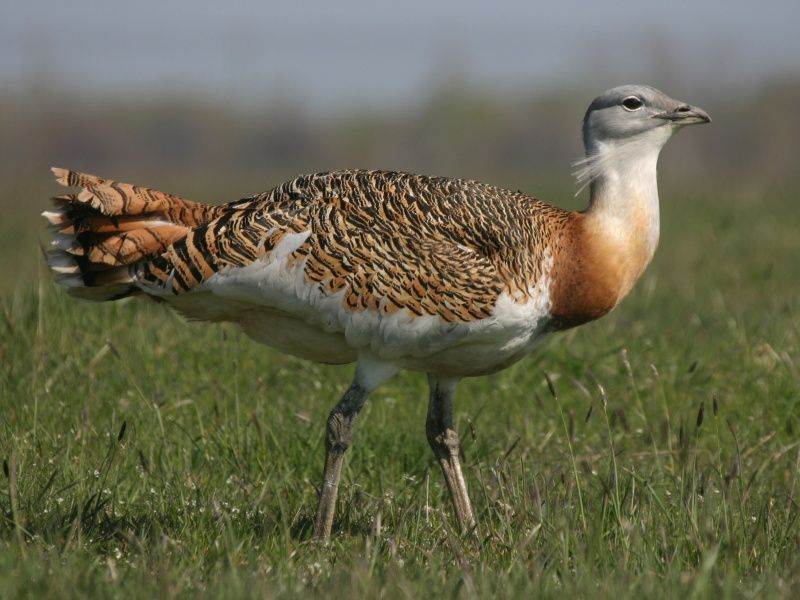
The great bustard is a large bird belonging to the bustard family and is the only living member of the genus Otis. It inhabits open grasslands and farmland, and its range stretches from northern Morocco, South, and Central Europe, to temperate Central and East Asia.
This species is one of the heaviest flying birds in the world, with males weighing up to 18 kilograms, while females can reach up to 10 kilograms. The great bustard has a large, rounded body, long neck, and short legs.
Its plumage is mainly white with black patches on its wings and tail. Males are larger than females, with a more pronounced black pattern on their feathers. The great bustard feeds mainly on insects, small reptiles, and other invertebrates that it finds on the ground.
It will also eat some seeds and grains. During the breeding season, it will also feed on small mammals and eggs. The great bustard is an endangered species due to habitat destruction and hunting.
Its populations are declining in many countries, including Morocco, Spain, and Russia. Conservation efforts have been undertaken to protect this species, including the creation of protected areas and enforcement of hunting regulations.
| Kingdom | Animalia |
| Phylum | Chordata |
| Class | Aves |
| Order | Otidiformes |
| Family | Otididae |
| Genus | Otis |
| Species | O. tarda |
7. European Turtle Dove
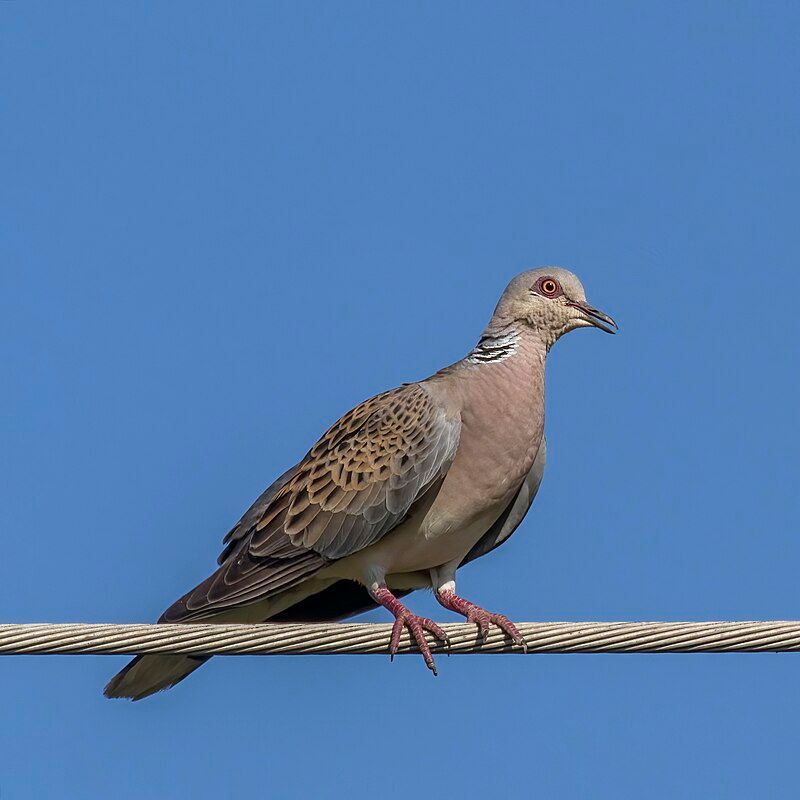
The European turtle dove is a species of bird that belongs to the family Columbidae, which includes doves and pigeons. It has a wide range of habitats across the southwestern region of the Palearctic, stretching from north Africa to central Eurasia.
During the summer months, the European turtle dove breeds in these areas, but when winter arrives it migrates to northern sub-Saharan Africa to escape the cold. This species is an important link in the global food chain, as it helps disperse seeds and fruits across its range.
The European turtle dove is an important indicator of healthy ecosystems, as its presence is a sign of a healthy environment. Sadly, its population is decreasing due to habitat destruction and climate change.
Conservation efforts must be taken in order to ensure that this species survives for future generations.
| Kingdom | Animalia |
| Phylum | Chordata |
| Class | Aves |
| Order | Columbiformes |
| Family | Columbidae |
| Genus | Streptopelia |
| Species | S. turtur |
8. White Stork
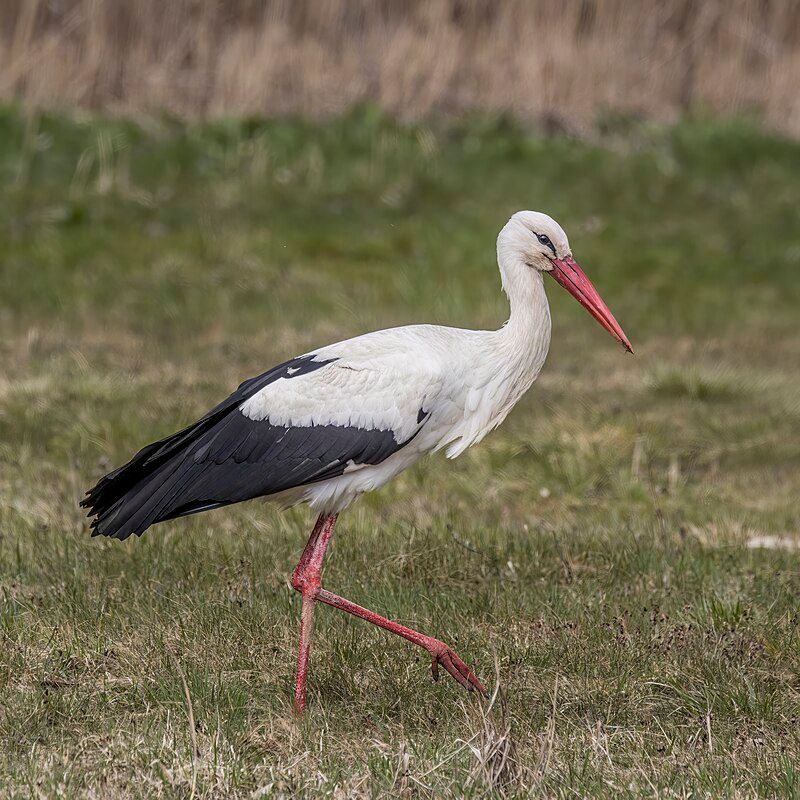
The white stork is an impressive bird found in the Ciconiidae family. It has a striking appearance, mainly white with patches of black on its wings. Adults have long red legs and an equally long pointed beak, the latter being red in color.
It has an average length of 100-115 cm from beak tip to tail tip, with a wingspan measuring between 155-215 cm. This makes the white stork a particularly large bird, one that is easily recognizable due to its distinct feathers.
It is a powerful flier, capable of making long journeys in search of food. It is also an intelligent bird, able to adapt to its environment and find new sources of sustenance.
The white stork has been a part of many cultures and traditions over the centuries, and it continues to be a popular bird to this day.
| Kingdom | Animalia |
| Phylum | Chordata |
| Class | Aves |
| Order | Ciconiiformes |
| Family | Ciconiidae |
| Genus | Ciconia |
| Species | C. ciconia |
9. Demoiselle Crane
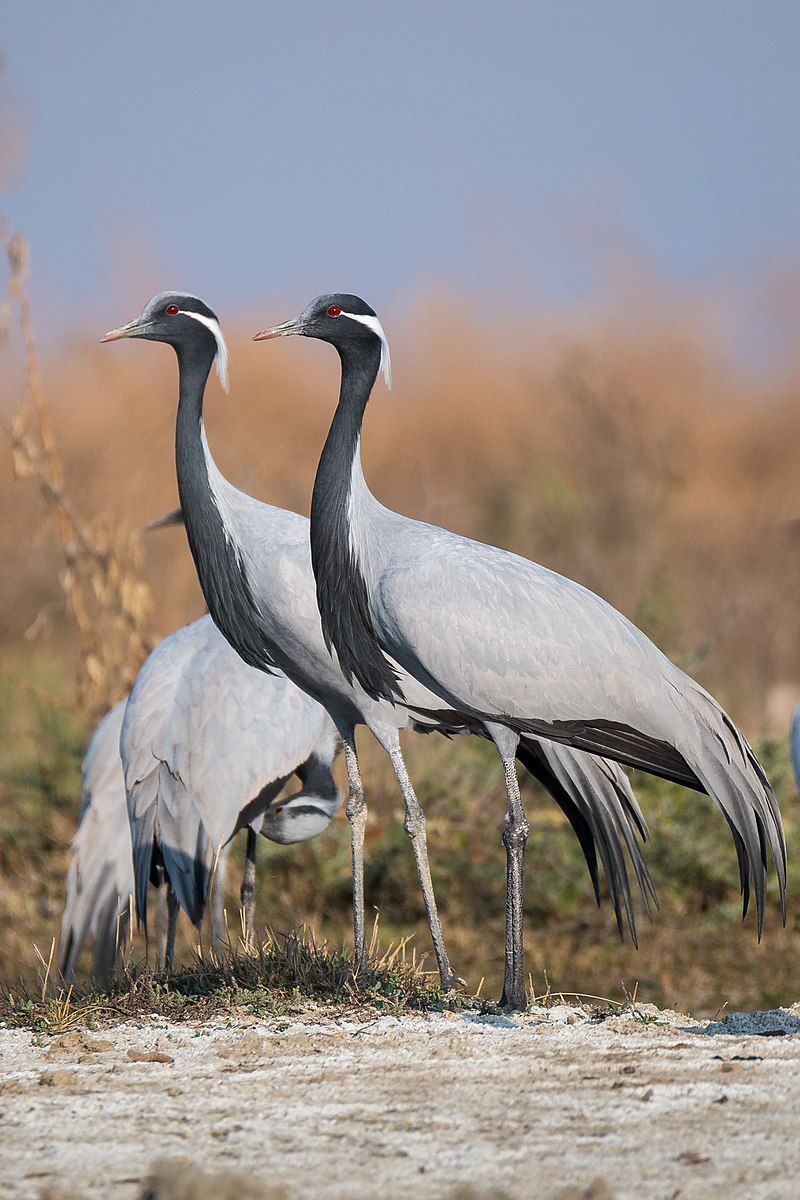
The demoiselle crane is a species of crane that is found in a wide area of Central Eurosiberia. It is native to the region that stretches from the Black Sea to Mongolia and Northeast China.
In addition to this range, a small breeding population of demoiselle cranes is also present in Turkey. These cranes are classified as migratory birds, which means that they move from one area to another in order to find food or more suitable living conditions.
This behavior is common among many species of birds in order to cope with changes in their environment and to take advantage of the seasonal resources that are available.
The demoiselle cranes typically migrate from their breeding areas in the summer months to their wintering grounds, usually in the south. During the winter, they will stay in one place for a period of time before flying back to their breeding grounds in the spring.
| Kingdom | Animalia |
| Phylum | Chordata |
| Class | Aves |
| Order | Gruiformes |
| Family | Gruidae |
| Genus | Grus |
| Species | G. virgo |
10. Alcedo Atthis
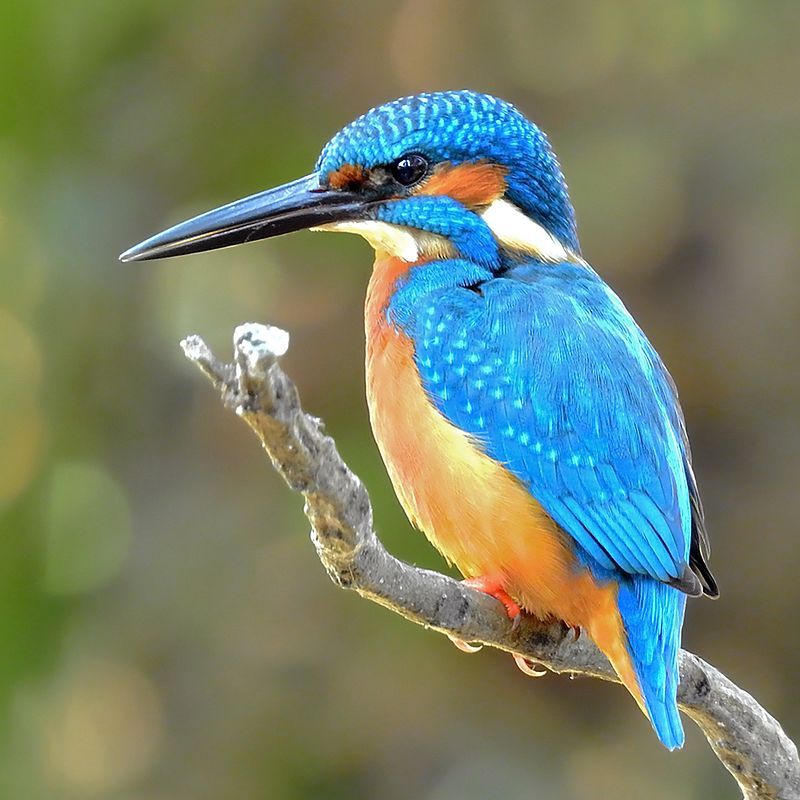
The common kingfisher, also known as the Eurasian kingfisher and river kingfisher, is a brightly colored bird native to Eurasia and North Africa. It is a small species of kingfisher that has seven recognized subspecies.
The common kingfisher has a wide distribution across its range and is generally a resident species. However, it does migrate from areas where the rivers freeze over in the winter. This is likely an adaptation to the cold temperatures and lack of food in these areas.
The common kingfisher is most commonly found near rivers, streams, and ponds where it can find the fish and aquatic invertebrates that make up its diet. Its bright colors, including its blue-green back, orange chest, and white belly, make it easy to spot.
The common kingfisher is a beautiful species that plays an important role in the local ecosystems.
| Kingdom | Animalia |
| Phylum | Chordata |
| Class | Aves |
| Order | Coraciiformes |
| Family | Alcedinidae |
| Genus | Alcedo |
| Species | A. atthis |
11. Pied Avocet
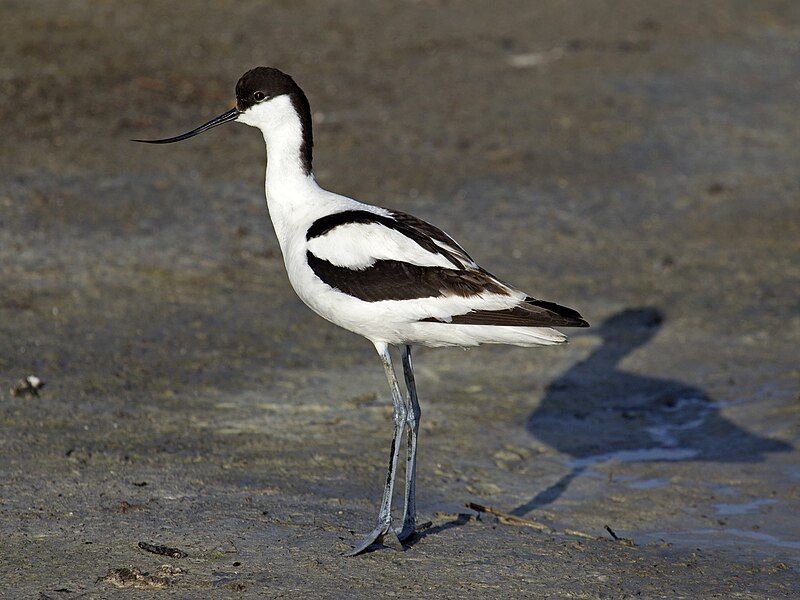
The pied avocet is a species of wading bird that belongs to the avocet and stilt family, Recurvirostridae. It is a large bird, characterized by its striking black and white plumage.
This species is found in temperate regions of Europe, as well as across the Palearctic to Central Asia and the Russian Far East. It is a migratory species, with most populations spending the winter months in Africa or southern Asia.
The pied avocet is an adaptable species, often found in a wide variety of wetland habitats, such as lakes, lagoons, marshes, and coastal mudflats. It feeds mainly on small aquatic invertebrates, such as crustaceans, mollusks, and insects.
This species is not currently considered threatened, although its population is gradually declining due to habitat loss and changes in water levels.
| Kingdom | Animalia |
| Phylum | Chordata |
| Class | Aves |
| Order | Charadriiformes |
| Family | Recurvirostridae |
| Genus | Recurvirostra |
| Species | R. avosetta |
12. Syrian Woodpecker
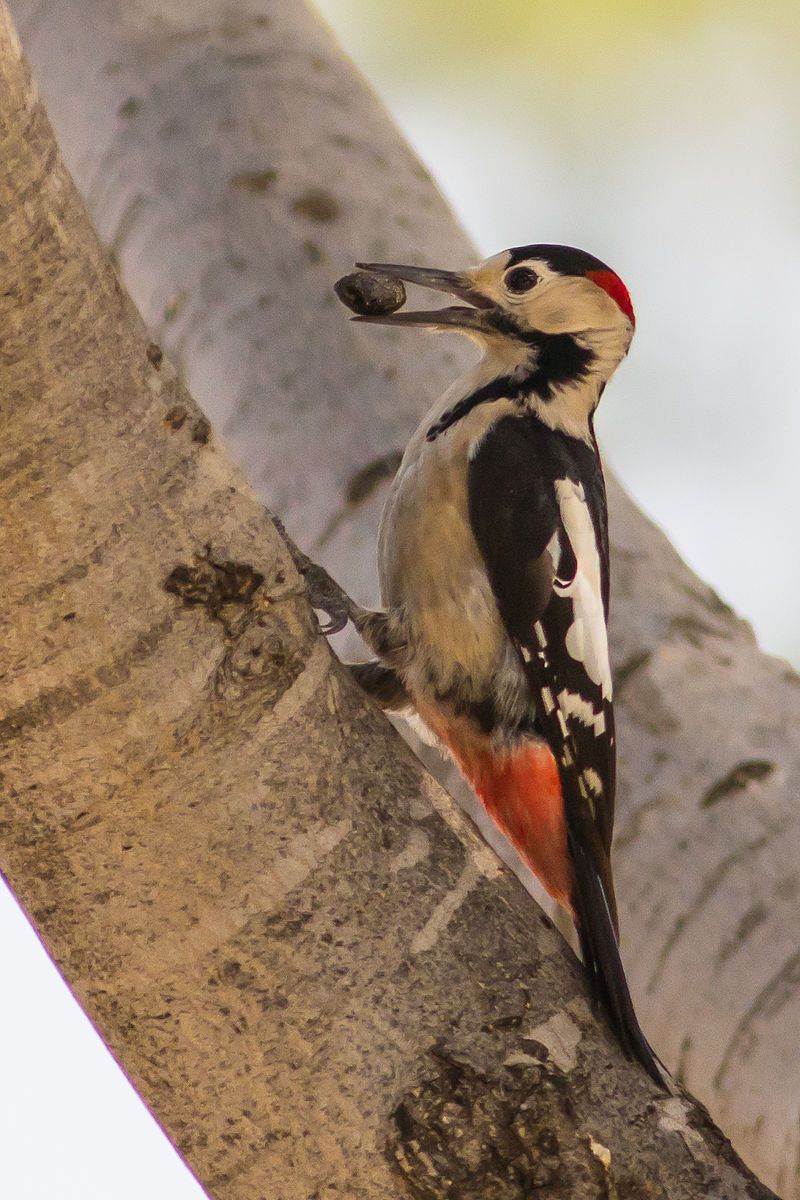
The Syrian woodpecker is a species of bird that belongs to the family Picidae, commonly known as woodpeckers. The members of this family are found throughout the world and are recognizable by their large, distinctive bills and loud, tapping calls.
Syrian woodpeckers are small-to-medium-sized birds, with a black-and-white striped pattern along their head and chest. Their bills are long and pointed, enabling them to reach deep into the bark to find insects.
The males tend to have a red patch on the back of their heads, while the females lack this feature. The Syrian woodpecker is found mainly in the Middle East, inhabiting forests, woodlands, and parklands.
They feed mainly on insects, which they locate by tapping on trees and shrubs. Syrian woodpeckers are solitary birds, but can often be seen in pairs or small groups.
They roost in tree cavities during the night and build their nests in tree cavities as well. The Syrian woodpecker is an important species, both ecologically and culturally.
It plays an important role in maintaining healthy wooded habitats by feeding on insect pests and is also a symbol of peace and unity in Syria. As such, it is an important species to conserve and protect.
| Kingdom | Animalia |
| Phylum | Chordata |
| Class | Aves |
| Order | Piciformes |
| Family | Picidae |
| Genus | Dendrocopos |
| Species | D. syriacus |
13. Middle-spotted Woodpecker
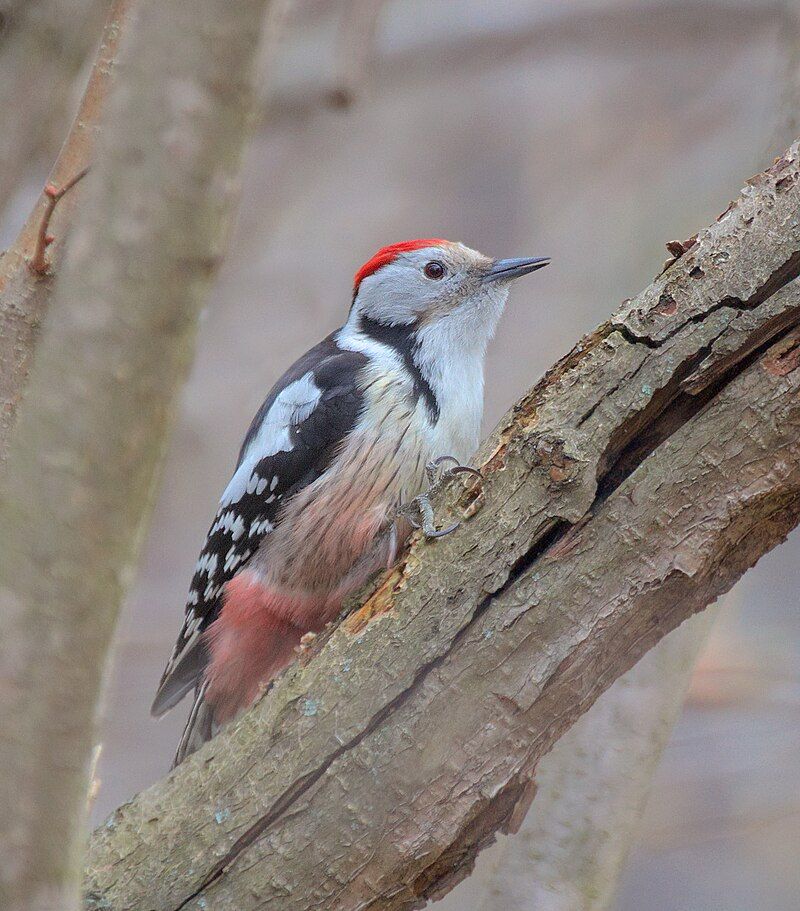
The middle-spotted woodpecker is a species of woodpecker that is native to Europe. It is a member of the genus Dendrocoptes, which is part of the Picidae family.
The middle spotted woodpecker is a medium-sized bird, measuring approximately 25 cm in length and weighing approximately 70 g. It has a black head, red chest, and white spots on its wings and back. Its beak is black and its legs are pinkish-red.
Its diet consists mainly of insects and larvae, but it also eats fruit and nuts. It is typically found in wooded areas, but it may also be found in parks and gardens. It is a solitary bird, but it may form small flocks during migration.
It is a protected species in some countries, and its population is declining due to deforestation and other habitat destruction.
| Kingdom | Animalia |
| Phylum | Chordata |
| Class | Aves |
| Order | Piciformes |
| Family | Picidae |
| Genus | Dendrocoptes |
| Species | D. medius |
Conclusion
Trabzon is home to a wide variety of birds, many of which are unique to the region. From the elegant Red-breasted Goose to the colorful Bee-eater, the birds of Trabzon offer a great opportunity for birdwatchers to observe a range of species in their natural habitats.
With its stunning landscape, rich biodiversity, and diverse birdlife, Trabzon is certainly an ideal destination for birders and wildlife enthusiasts from all over the world.